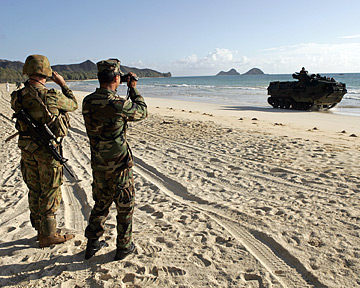
ASSOCIATED PRESS
Australian Navy Chief Petty Officer Matt Hanrahan, left, and U.S. Navy Lt. Sean Slappy observe an amphibious assault vehicle rolling down the beach at Marine Corps Training Area Bellows as part of RIMPAC exercises in Waimanalo.
|
|
Isle economy gains from RIMPAC
Military personnel will contribute $30 million as exercises wrap up
Nearly 19,000 military personnel from eight countries are expected to leave nearly $30 million in Hawaii as the 20th multinational Rim of the Pacific exercise ends this week.
Some of the 35 ships that participated in nearly monthlong naval war games were to begin steaming into Pearl Harbor early this morning.
This year's naval war games, considered the largest in the world, were the first that had to operate under environmental restrictions on the use of active sonar because of its possible effects on whales and other marine mammals.
Two years ago, during the last RIMPAC exercise, more than 150 melon-headed whales stranded themselves in Hanalei Bay on Kauai. A federal government investigation concluded that the Navy's sonar use was the "plausible, if not likely" cause of the stranding.
No such problems were reported this year.
But a series of large explosions Sunday off Ewa Beach that were part of a mine-clearing exercise spooked some residents.
The Navy said it had warned the Coast Guard in advance, but residents in the area had received no prior notice.
The use of active sonar for anti-submarine exercises was considered one of the key points of the RIMPAC exercises.
In a written statement issued yesterday, Vice Adm. Barry Costello, commander of the 3rd Fleet, said: "The exercise was a tremendous opportunity to learn and improve how we work together, but more importantly, RIMPAC continues to build positive relationships among allied nations who share a common interest in peace, security, and stability in the region."
Participants included Australia, Japan, Chile, Canada, Peru, South Korea and the United Kingdom.

